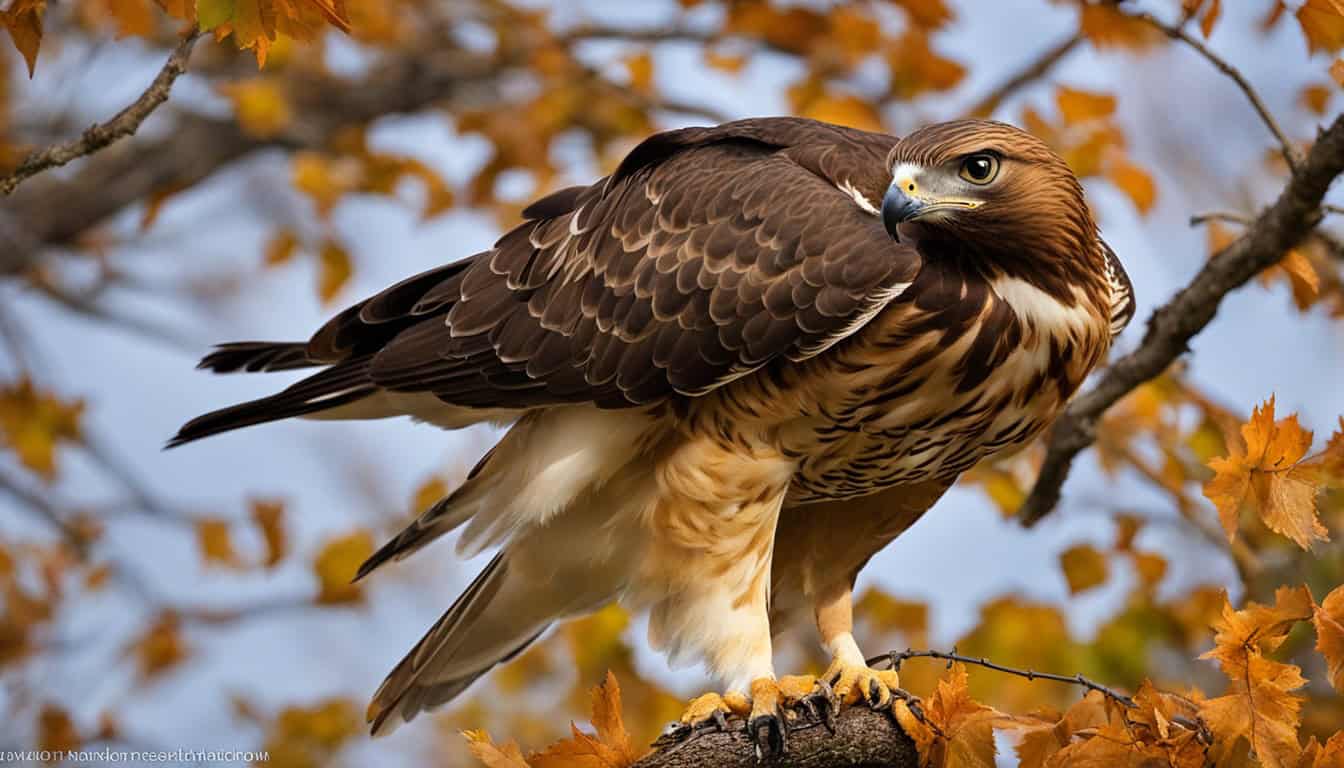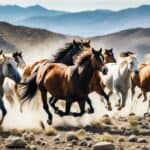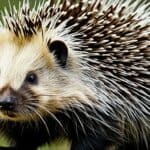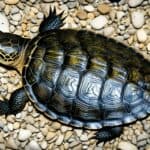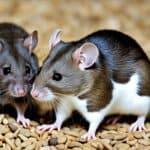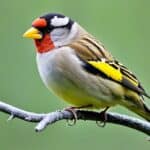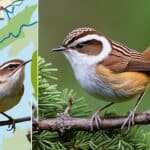The red-tailed hawk diet shows how adaptable they are across North America. They’re one of the most common birds of prey. To know what they eat, we look at their varied prey and how they hunt.
Red-tailed hawks have great eyesight and strong talons. They mainly eat small mammals, birds, and reptiles. They find food wherever they can, in fields or in cities. By studying what they eat, we see how important they are for the environment.
Introduction to the Red-tailed Hawk
The red-tailed hawk is a key type of North American raptors. It stands out for its adaptability and wide distribution. You can spot it by its unique red tail. Its sharp vision, strong talons, and sturdy body make it a strong hunter.
Overview of Red-tailed Hawk
Red-tailed hawks have big wings and striking feathers. They live in many places, like grasslands, deserts, and urban areas. This shows their ability to adjust to different places. It makes them very common in North America.
Importance of Understanding Their Diet
Knowing what red-tailed hawks eat is key to keeping the ecosystem healthy. They help keep the numbers of small animals, birds, and reptiles in check. It’s important to watch what they eat to protect their environment, especially in cities.
| Aspect | Description |
|---|---|
| Red-tailed Hawk Characteristics | Known for their excellent eyesight, sharp claws, and red tail feathers. |
| Red-tailed Hawk Habitat | They live in various places like grasslands, deserts, and even cities. |
| Role in Ecosystem | Vital for keeping small animal, bird, and reptile populations in check. |
What is the diet of a red-tailed hawk?
Red-tailed hawks are known for being flexible and opportunistic in what they eat. They eat mostly mammals, but their diet can change based on what’s around. This makes their specific diet different from place to place.
They are skilled at hunting a variety of prey. Usually, they go for small or medium-sized animals like rodents and rabbits. They pick their prey depending on what’s easiest to catch.
In different settings, red-tails choose different meals. In the country, they aim for small mammals. In the city, they might go after pigeons. This shows how they can live and eat in many places.
Red-tailed hawks are great at hunting because of their sharp vision. From up high or while flying, they can spot their next meal. Then, they dive fast and use their strong talons to grab it. This method shows their hunting skills well.
| Environment | Common Prey | Feeding Strategy |
|---|---|---|
| Rural | Rodents, rabbits, squirrels | Soaring and diving, perching to spot prey |
| Urban | Pigeons, small birds | Diving from buildings, spotting from perches |
If we look at what red-tailed hawks eat, we see something interesting. They mainly target mammals but are open to other options. This flexibility helps them survive in different settings all year round.
Common Prey of the Red-tailed Hawk
The red-tailed hawk hunts a wide array of prey. It feeds on small mammals, birds, and reptiles. Knowing what the red-tailed hawk eats helps us understand how and what it hunts.
Rodents
Rodents are a key part of the red-tailed hawk’s diet. Hawks commonly go after mice, voles, and ground squirrels. With sharp vision and strong claws, they are able to capture these creatures easily. They often sit quietly on a perch and then quickly grab their prey.
Birds
Birds are another big part of the red-tailed hawk’s food. They catch different kinds of birds using tactics like surprise attacks. Their targets range from small to large birds. Their hunting methods show how skilled they are at catching various bird species.
Reptiles
Reptiles also feature on the red-tailed hawk’s menu. In hot areas, hawks eat snakes and lizards. What they catch changes depending on what’s around. They dive down to take reptiles using their sharp claws. This shows their ability to adapt and hunt different types of prey.
Small Mammals in the Red-tailed Hawk’s Diet
Red-tailed hawks are skilled at hunting small mammals. They have many ways to catch their prey. This makes them successful hunters in different places.
Types of Small Mammals
Voles, rabbits, and shrews are common prey for red-tailed hawks. What they hunt depends on where they live. They choose these animals because they are easy to find and catch.
Hunting Techniques for Small Mammals
One main way red-tailed hawks hunt is by watching quietly from a perch. They use their keen eyes to spot movement. Then, in a quick flight, they grab their prey with strong claws. This shows how skilled they are at catching food.
| Prey Type | Typical Hunting Technique |
|---|---|
| Voles | Swooping from a high perch |
| Rabbits | Low gliding and grabbing |
| Shrews | Quick striking from a low height |
Birds as Part of the Red-tailed Hawk’s Diet
Red-tailed hawks are top-notch hunters. They mainly eat other birds and use many ways to catch them.
Types of Birds Preyed Upon
These hawks really like smaller birds like sparrows and starlings. They also hunt quails and waterfowl when they have the chance. This mix of prey helps them live in different places.
Strategies for Hunting Birds
Red-tailed hawks have several clever ways to get their bird meals. They fly high, perch quietly, and suddenly attack. Their hunting plans are smart and patient.
Working together is also part of their hunting game. They hunt with their mates to catch harder things like squirrels. This shows how well they can adapt and work as a team in nature.
Feeding Habits and Hunting Behavior of the Red-tailed Hawk
The red-tailed hawk’s feeding habits and hunting style are vital in our ecosystem. They eat differently every day and change what they eat as the seasons shift. It’s interesting to look at how they find food daily and adjust their diets.
Daily Feeding Habits
Red-tailed hawks eat at set times every day. Mornings and evenings are when they hunt the most. This matches when their prey, like small birds and rodents, are out.
They choose these times to make their hunts more successful. The weather matters too. On hot days, they might hunt early or late to stay cool.
Seasonal Variations in Diet
Seasons change what red-tailed hawks eat. In warm months, they feast on rodents and rabbits. But when it’s cold, these meals are harder to find.
So, the hawks switch to birds and reptiles. This shows how seasonal diet changes in raptors help them adapt to their environment.
| Season | Primary Prey | Alternative Prey |
|---|---|---|
| Spring | Rodents | Small Birds |
| Summer | Rabbits | Reptiles |
| Fall | Small Mammals | Squirrels |
| Winter | Birds | Reptiles |
Adaptations for Hunting and Feeding
The red-tailed hawk adaptations are key to its success as a bird of prey. These birds have physical and behavioral traits that boost hunting skills. A major asset is their amazing eyesight. They can see prey far away because their eyes are about eight times sharper than ours.
Their strong and sharp talons are also crucial. These claws help them grab prey strongly and quickly. With these talons, they can catch small animals, birds, and even reptiles.
The raptor hunting skills of these hawks also include their unique flying abilities. They can fly in ways that let them sneak up on prey silently. This makes them highly skilled at capturing food in different habitats and situations.
Here is a table that outlines the prey capture adaptations of red-tailed hawks:
| Adaptation | Description | Benefit |
|---|---|---|
| Visual Acuity | Extremely sharp vision | Detects prey from long distances |
| Powerful Talons | Strong and sharp claws | Ensures firm grip and swift kill |
| Flight Maneuverability | Skilled in both soaring and ambushing | Versatile hunting strategies |
| Stealth | Quiet and efficient movement | Surprises and catches prey off guard |
Learning about these red-tailed hawk adaptations sheds light on their impressive hunting abilities. It shows why they are top predators in the bird world.
Impact of Habitat on Diet
The red-tailed hawk changes what it eats based on its home. This is true for both countryside and cities. These hawks find new ways to hunt as the city grows.
Rural vs. Urban Hunting Grounds
In the country, red-tailed hawks go after small animals like rabbits. They use their eyes and the sky to catch prey in wide-open spaces. Yet, in the city, they eat more birds and small mammals.
Impact of Habitat Changes
As cities grow, so does what these hawks eat. They start to like city birds and even what people throw away. This shows how they learn new ways to get food in their new homes.
| Habitat | Primary Prey | Hunting Techniques |
|---|---|---|
| Rural | Rodents, Rabbits, Reptiles | Swooping, Soaring |
| Urban | Birds, Small Mammals, Refuse | Perching, Surprise Attacks |
Learning how a change in where they live affects what red-tailed hawks eat is key. It helps us help them live well, even as the world around them changes.
Red-tailed Hawk Food Sources in Different Regions
Red-tailed hawks find food in different ways depending on where they live in North America. Their food sources change due to the kind of place they are in, the weather, and what they can hunt. This helps them survive in many different places across the continent.

Hawks living in the woods often catch small creatures like squirrels and voles. Meanwhile, those on the open grasslands prefer hunting for mice and rabbits. Their diets show how well they adjust to their homes and the hunting they need to do.
In cities, where their usual prey might be hard to find, red-tailed hawks have been seen hunting pigeons and other birds that live near people. This shows how adaptable and skilled these hawks are, no matter if they’re in natural or human-made settings.
| Region | Common Prey |
|---|---|
| Forests | Squirrels, voles, small birds |
| Prairies | Mice, rabbits, ground-dwelling birds |
| Urban Areas | Pigeons, city birds, small mammals |
Nutritional Requirements of the Red-tailed Hawk
It’s key to know what red-tailed hawks eat to understand their health and activities. They carefully choose food that gives them all they need to live well in the wild.
Key Nutrients
Red-tailed hawks need lots of proteins, fats, and vitamins. Proteins help build and keep their muscles strong. Fats give them the energy they need, especially when flying for long periods or hunting.
Calcium and phosphorus are also important. They help with bone strength and making strong eggshells during breeding.
How Their Diet Meets Their Nutritional Needs
Red-tailed hawks eat various animals to get the nutrition they need. They catch small mammals, birds, and reptiles. This way, they get proteins and fats, like from rodents, birds, and reptiles. Each type of prey offers something different, ensuring the hawks stay healthy and can reproduce successfully.
The diet of a red-tailed hawk is balanced through eating a mixture of prey. This varied food is needed for their survival. It helps them be effective predators in North America.
FAQ
What is the diet of a red-tailed hawk?
Red-tailed hawks mainly eat small mammals like rodents, rabbits, and voles. They also eat birds, reptiles, and sometimes insects. Carrion, or dead animals, isn’t off the menu for them either.
Why is it important to understand the diet of red-tailed hawks?
Knowing what red-tailed hawks eat is key for us. It helps in conservation and shows us their role in nature. It also helps us see how they survive and adapt, especially as the world changes.
What role do rodents play in the diet of a red-tailed hawk?
Rodents are a big part of a red-tailed hawk’s diet. They often eat voles, mice, and rats. Eating these rodents gives hawks the energy and nutrients they need.
How do red-tailed hawks hunt small mammals?
Red-tailed hawks are excellent hunters. They rely on their sharp vision and skillful hunting tactics. Often, they wait quietly and then dive quickly, grabbing their prey with their strong claws.
What types of birds do red-tailed hawks prey upon?
Red-tailed hawks hunt many birds, like pigeons, doves, and smaller songbirds. They use clever hunting methods and sometimes work together to catch these fast-flying birds.
How do red-tailed hawks hunt birds?
When hunting birds, red-tailed hawks are swift and stealthy. They might surprise their prey with aerial tricks. They take birds down in flight with their sharp talons.
What are the daily feeding habits of red-tailed hawks?
Red-tailed hawks typically hunt and eat during the daytime. They’re most active in the morning and late afternoon. How often they eat depends on food availability and the time of year.
Do red-tailed hawks’ diets change with the seasons?
Yes, the diet of red-tailed hawks does change. Certain times bring more of their favorite food, so they adjust. The movement of their prey, like bird migrations, can also change what they eat.
What adaptations help red-tailed hawks hunt effectively?
Red-tailed hawks are built for hunting. They have great eyesight and powerful talons. Plus, how they fly helps them sneak up on their prey.
How does habitat impact the diet of red-tailed hawks?
Where red-tailed hawks live affects what they eat. In the countryside, they eat more rodents. In cities, their diet might include more pigeons. This is because different places have different kinds of food for them.
How do geographic regions affect the food sources for red-tailed hawks?
The area where red-tailed hawks are found changes what they eat. Different places offer different animals to hunt. Things like weather and human activities also affect the hawks’ diet.
What key nutrients do red-tailed hawks need?
Red-tailed hawks must have a diet packed with proteins, fats, and important vitamins. They get these nutrients from a mix of mammals, birds, and reptiles. This variety keeps them healthy and strong.
How does the red-tailed hawk’s diet fulfill its nutritional needs?
To stay healthy, red-tailed hawks need a balanced diet. They eat various animals to get the proteins and fats they require. This diet keeps their muscles, feathers, and whole body in top condition.

